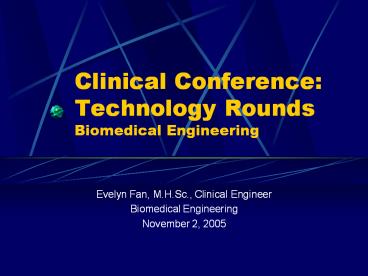Clinical Conference: Technology Rounds Biomedical Engineering - PowerPoint PPT Presentation
1 / 25
Title:
Clinical Conference: Technology Rounds Biomedical Engineering
Description:
Clinical Conference: Technology Rounds Biomedical Engineering Evelyn Fan, M.H.Sc., Clinical Engineer Biomedical Engineering November 2, 2005 Plan for today ... – PowerPoint PPT presentation
Number of Views:97
Avg rating:3.0/5.0
Title: Clinical Conference: Technology Rounds Biomedical Engineering
1
Clinical ConferenceTechnology RoundsBiomedical
Engineering
- Evelyn Fan, M.H.Sc., Clinical Engineer
- Biomedical Engineering
- November 2, 2005
2
Plan for today
- Introduction
- Biomedical Engineering OR Team
- Fabius GS Low Fresh Gas alarm
- Fresh gas decoupling
- Youre on call
- Whats wrong with this picture?
- Summary
- Conclusion
3
Who are we?
- BWH Biomedical Engineering Department
- 27 people
- 3 teams (OR, ICU, Ambulatory) support the medical
equipment used in the entire hospital and
outside clinics - Responsible for managing and supporting 15,735
medical devices - OR team specifically manages all operating room
equipment, including CPD, and Anesthesia for
outside areas such as Endoscopy, MRT/ MRI, Angio/
Cath lab, etc. - 3114 medical devices managed by the OR team
- 2088 of which have a risk class of Life-Support/
High-Risk/ Normal, meaning they require
scheduled maintenance at least 1x/ yr. - 63 anesthesia machines, which require scheduled
maintenance 2x/ year.
4
OR Biomed Team
- Ernst Daniel, Clinical Engineer
- Evelyn Fan, Clinical Engineer
- Dr. Jim Philip, Medical Liaison
- Eddie Holmes, Facilities Technician
- Claire Cabral, Sr. BMET
- Garth Meikle, Sr. BMET
- Ross Jacques, BMET
5
What does biomed do?
- Vision It is our goal that no patient is harmed
by the application of a medical device within our
sphere of influence. - Goal To be a Solutions Department, providing
technology solutions to advance the care and
safety of patients and staff. - Repairs Scheduled Maintenance (SM) of
clinically used equipment, projects/
installations, on-call/ night-call coverage,
incident investigations, capital equipment
purchases, etc. - Work with many departments including OR/CSS,
anesthesia techs, CPD, Anesthesia, Nursing,
Infection control, Perfusion, Environmental
Affairs, Risk Management, etc. - More details to come in future article for the
Anesthesia Record
6
Fresh Gas Low alarm
7
Bellows vs. Piston
8
What is Fresh Gas Decoupling?
Water Trap
9
Inhalation
Inhalation
O2 sensor
Pressure sensor
Inspiratory valve
Expiratory valve
10
Exhalation
11
What does the water trap have to do with the
Fresh Gas Low alarm?
12
What does the water trap have to do with the
Fresh Gas Low alarm?
- During expiration, piston moves down to actively
fill with fresh gas ? negative pressure created - Water in ventilator hose creates occlusion ?
higher negative pressure detected by pressure
transducer - Interpreted electronically by machine as Low
Fresh Gas alarm.
13
Youre on call..
- OR 18, Fabius GS, Anesthesiologist calls you
- Reports a Low Fresh Gas alarm
14
Lets take a closer look..
- Gas monitor exhaust line is unhooked from circuit
- SAM module is pulling 200mL/min leak!
15
And the solution is
- Gas monitor exhaust line should be attached to
expiratory gas sampling port connector - Or should be attached to scavenging
16
What is wrong with this picture?
17
What alarm would you see?
18
- Fresh gas decoupling
- Room air entrainment
- Piston is electronically driven by the motor
- No ADS alarms
With no bag present, piston draws in room air
19
Summary
- Fresh gas decoupling
- Good Motor-driven piston results in minimal
tidal volume changes with FGF changes - Bad If bag is empty (ie. low flow) ADS may
alarm if bag is missing can lead to room air
entrainment ? dilution of agent - Since the reservoir bag is a part of your
circuit, make sure your reservoir bag is attached
to the bag arm at all times!
- What to do when you see a Low Fresh Gas alarm
- Check the water trap
- Check for a deflated reservoir bag (which may
indicated the presence of a leak!) - Check the breathing circuit
- Call biomed ? (pager 11055)
20
Conclusion
- Ask Biomed
- Email Evelyn Fan (efan1_at_partners.org)
- Cc Dr. Jim Philip (jphilip_at_zeus.bwh.harvard.edu)
- Look out for upcoming article in Anesthesia
Record about biomedical engineering - Questions?
21
Acknowledgements
- Special thanks to
- Dr. J. Philip, Medical Liaison
- Garth Meikle, Sr BMET Ross Jacques, BMET
- OR Biomedical Engineering team
- Drager Medical Technical Support
22
Additional Slides
23
What happens to O2 when reservoir bag is removed
from circuit?
24
What happens to O2 when reservoir bag is removed
from circuit?
25
What happens to O2 when reservoir bag is removed
from circuit?































